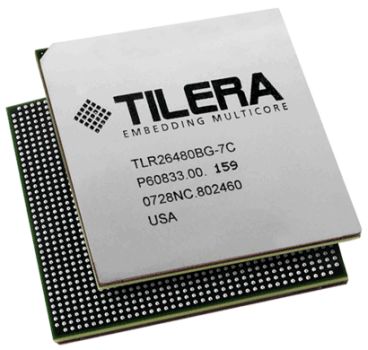Tilera Launches Third-Generation Chips

Tilera has released its latest 36- and 16-core server processors, offering performance and energy efficiency improvements
At a time when Intel and ARM Holdings are getting most of the press around low-power server processors, Tilera officials are continuing to push their own architecture.
Tilera took its latest step on 30 January, announcing the general availability of its latest 36- and 16-core chip, which officials said will offer the performance and energy efficiency that are increasingly in demand by networking, multimedia and cloud businesses.
Company officials believe that a server powered by a Tile-Gx36 chip will offer greater performance than a system running on a Xeon chip from Intel, and will use a fifth of the power and an eighth of the space.
Compute-per-watt
Such numbers will be attractive to many businesses, according to Bob Doud, Tilera’s director of marketing.
“For some people, like cloud providers, compute-per-watt is their biggest concern,” Doud said in an interview with eWEEK.
 It’s the reason chip makers, from Intel and Advanced Micro Devices to ARM and its manufacturing partners, are working to create chips that can be used in low-power, high-performance systems in what is becoming an increasingly competitive segment of the server industry.
It’s the reason chip makers, from Intel and Advanced Micro Devices to ARM and its manufacturing partners, are working to create chips that can be used in low-power, high-performance systems in what is becoming an increasingly competitive segment of the server industry.
Tilera, which also announced the return of founder Devesh Garg as its chief executive, got a boost last summer, when social networking giant Facebook said its tests found that a Quanta Computer system powered by 64-core Tilepro64 chips offered three times the performance-per-watt of servers running Intel’s quad-core Xeon chips and more than four times than servers running AMD’s eight-core Opteron chips.
Tilera officials said they are looking to build on that momentum with the release of their third-generation processors, which offer significant enhancements, including 64-bit computing capabilities, and will be built on a 40-nanometre manufacturing process, rather than the 90nm process of the company’s previous offerings.
Along with the chips, Tilera also is offering three evaluation systems in multiple form factors that include 1U (1.5-inch) servers and a Peripheral Component Interconnect Express (PCIe) card, which holds a 16- or 36-core chip. The appliances will offer either a single 36-core processor or four 36-core chips, for a total of 144 cores. More boards and systems will be coming from Tilera partners later in the year, the company said.
100-core chips
Tilera, which has the financial backing of such companies as Cisco Systems, Quanta and Samsung Ventures, first made headlines in 2009, when officials talked of 100-core chips and the way the chips are organised in a highly parallelised mesh fashion with a large number of interconnects between the cores.
The goal is to create chips that offer high performance and low power consumption, which is important to companies like Facebook, Google and Microsoft, which are building densely populated data centres and are interested in keeping their costs down.
To date, Tilera has released 16-, 32- and 64-core chips. Doud said that the 64-core third-generation processor, as well as the first 100-core chip, would be released at the end of 2012. According to a report in Wired, as many as 200 cores could be featured on chips in 2013, when Tilera rolls out its upcoming “Stratton” line.
The company has seen a “staggering amount of demand” for the 16- and 36-core chips, he said. Tilera is working with 80 customers and has 20 design wins, including with the likes of Harmonic and Mercury Computer Systems. The company also supplies chips to Quanta.
Intel, with its microserver push, and AMD are both aggressively driving up the energy efficiency in their chips. In July 2011, SeaMicro rolled out its latest servers running on Intel’s low-power Atom processors.
The SM10000-64 HD offers 768 Atom processor cores, which improves the company’s compute density by 150 percent and per-watt performance by 20 percent, according to company officials.
At the Supercomputing 2011 show in November, Intel officials also showed off working samples of Knights Corner silicon, a chip with more than 50 cores designed to meet the twin demands in supercomputing for high-performance and low-power consumption.
Software support
Intel and AMD have the advantage of broad software support for their x86-based chips, though Tilera’s Doud noted that common Linux workloads can run on this company’s chips.
He also said that for some companies, the costs of porting their applications to a new architecture are far outweighed by the savings in power costs when using the Tilera technology.
ARM and several of its manufacturing partners, including Nvidia, Marvell Technologies and Calxeda, are working to push their ARM-based low-power chip designs – which currently dominate the smartphone and tablet markets – into servers.
ARM officials don’t expect to make a significant dent in the server business until 2014, when they will introduce designs with 64-bit computing. But some inroads already are being made.
Most notably was an agreement announced between HP and Calxeda to build prototype low-power servers using ARM-based processors. The initiative is part of HP’s larger Project Moonshot, in which company officials are hoping to develop extremely low-power servers to run in such environments as cloud and on-demand computing.